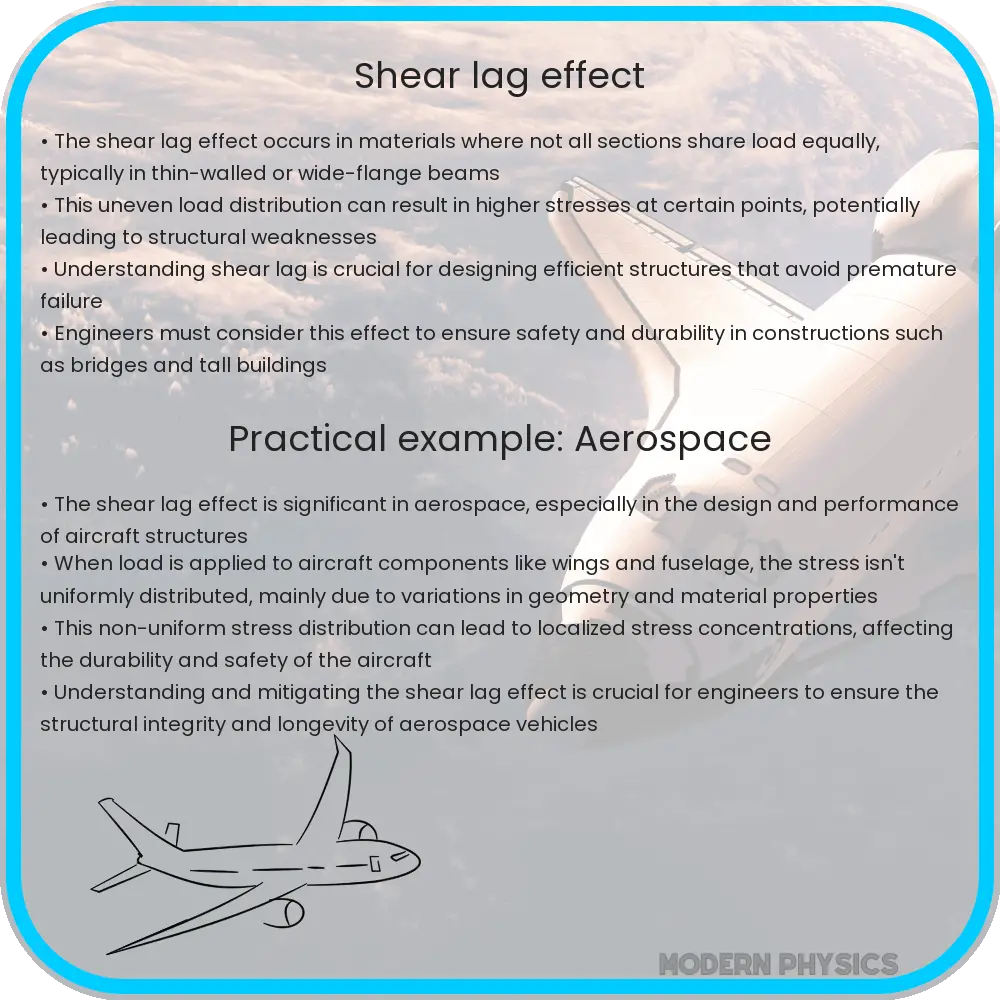Explore the significance, analysis, and solutions of the shear lag effect in statics, essential for structural integrity in engineering.

Understanding the Shear Lag Effect in Statics
The shear lag effect is a critical phenomenon in the field of structural engineering and statics, impacting the efficiency and safety of various structural components. It refers to the uneven distribution of stress in a member, particularly in slender components subjected to axial loads. This effect is most commonly observed in thin-walled structures like beams, columns, and aircraft fuselage. Understanding and addressing the shear lag effect is essential for ensuring the structural integrity and longevity of engineering projects.
Importance of Analyzing Shear Lag Effect
Ignoring the shear lag effect can lead to inaccurate stress predictions, potentially compromising structural safety. In engineering, safety factors are employed to account for uncertainties, but an understanding of the shear lag effect provides a more precise assessment of these factors. Structures designed without considering this phenomenon may experience unexpected failures or require additional maintenance and reinforcement, leading to increased costs and safety risks.
Analysis of Shear Lag Effect
To analyze the shear lag effect, engineers use various methods, including analytical approaches, numerical simulations, and experimental tests. Analytical methods involve equations that consider the geometry and material properties of the structure. Numerical simulations, like finite element analysis (FEA), provide a more detailed understanding by modeling complex structures and load conditions. Experimental tests validate the theoretical and computational models, ensuring their accuracy in real-world scenarios.
Solutions to Mitigate Shear Lag Effect
There are several strategies to mitigate the shear lag effect in structures. One common approach is to optimize the geometry of the component, such as altering the cross-sectional shape or thickness distribution. Material selection also plays a crucial role; using materials with higher stiffness or strength can reduce the severity of the effect. Additionally, engineers may incorporate stiffening elements, such as ribs or stringers, to improve the load distribution and reduce stress concentrations.
Advanced manufacturing techniques, like additive manufacturing, offer new possibilities in designing components that are resilient to shear lag. These techniques enable the creation of complex geometries that are difficult to achieve with traditional manufacturing methods.
Advanced Techniques in Shear Lag Analysis
Recent advancements in computational mechanics have significantly improved the analysis of the shear lag effect. High-performance computing enables detailed simulations of complex structures under varied loading conditions. Machine learning algorithms are being integrated to predict and optimize structural responses, providing insights beyond traditional analysis methods. These advanced techniques are invaluable for designing safer and more efficient structures, particularly in aerospace and civil engineering.
Case Studies and Real-World Applications
Understanding the shear lag effect is not just theoretical; numerous case studies across different sectors demonstrate its practical importance. For instance, in aerospace engineering, addressing the shear lag effect is crucial for designing aircraft wings and fuselage sections. In civil engineering, long-span bridges and high-rise buildings are analyzed for shear lag to ensure their ability to withstand wind and seismic loads.
These case studies often lead to innovative solutions that enhance structural performance. For example, the design of composite materials in aerospace has evolved to address shear lag, resulting in lighter and stronger aircraft components.
Future Directions in Shear Lag Research
The field of shear lag analysis is continually evolving, with research focusing on more sustainable and efficient solutions. Exploring new materials, such as nano-engineered composites and smart materials, holds promise for further reducing the impact of shear lag. Additionally, the integration of sustainable practices in design and manufacturing, considering the entire lifecycle of a structure, is becoming increasingly important.
Conclusion
The shear lag effect is a fundamental concept in structural engineering, essential for the safe and efficient design of slender members in various applications. Its importance lies in ensuring structural integrity and preventing unforeseen failures. Through advanced analysis techniques, innovative materials, and sustainable practices, engineers can effectively mitigate the challenges posed by shear lag. As technology progresses, the ongoing research and development in this field will continue to enhance our ability to design resilient and efficient structures, benefiting industries ranging from aerospace to civil engineering. The future of structural design is bright, with the shear lag effect playing a pivotal role in shaping innovative and sustainable engineering solutions.
